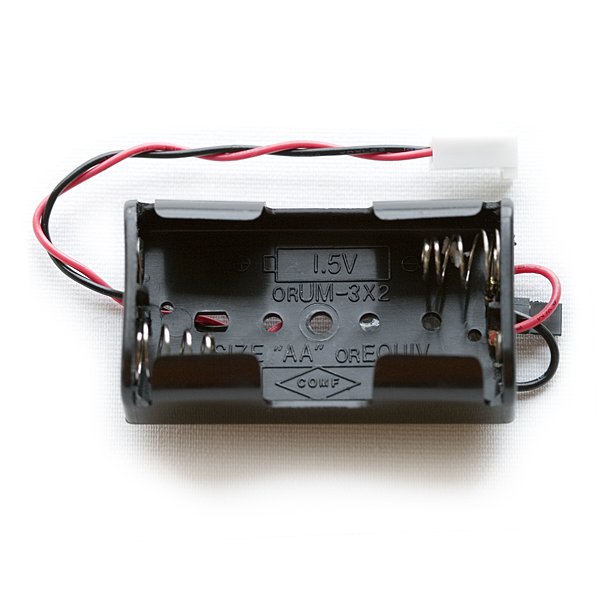5V DC to DC Step Up - 2xAA
The is a wonderfully simple 5V power source from Bodhilabs. This unit uses a two AA batteries and generates 5V using a DC to DC step up circuit. A jumper is provided on the unit to disconnect power and includes a terminated (right is red) connector. Perfect for all those 5V applications that need to be small, and run on less than 200mA.
Specifications:
- Voltage regulation: +5V +/-3%
- Typical current: 200mA or less.
- Typical ripple: 100mV peak-peak (*) @ 135kHz
5V DC to DC Step Up - 2xAA Product Help and Resources
Core Skill: Electrical Prototyping
If it requires power, you need to know how much, what all the pins do, and how to hook it up. You may need to reference datasheets, schematics, and know the ins and outs of electronics.
Skill Level: Rookie - You may be required to know a bit more about the component, such as orientation, or how to hook it up, in addition to power requirements. You will need to understand polarized components.
See all skill levels
Comments
Looking for answers to technical questions?
We welcome your comments and suggestions below. However, if you are looking for solutions to technical questions please see our Technical Assistance page.
Customer Reviews
No reviews yet.



Do not use this as power source for the Sound Detector board (SEN-12642). Ripple is too high. See Sound Detector Hookup Guide for explanation. ( https://learn.sparkfun.com/tutorials/sound-detector-hookup-guide/ )
Bought mine on the Saturday from the NYU computer store's component selection. And I noticed the connector style when I got it home. Who makes it? And where do I find a male connector to mate with it?
I think it's a molex which is 0.1" spaced. standard headers should work just fine.
Does anyone know what that jumper is covering? Is that the raw 3v output from the bateries?
This did not work with 1.2V rechargeable batteries. Needs 1.5V per battery.
Really? That's disappointing. Can anyone confirm? Also, is it true this drains batteries fast even without a load?
Could you hook this up to a USB wall charger (with requisite diode) and make it a system too that provides rechargeable USB power (for prototyping boards, cellphones, etc)?
Thanks, J
Does this scavenge power from 'dead' batteries the way that a Mintyboost circuit does?
The Mintyboost similarly uses a boost converter, so they should behave similarly in scavenging power from old batteries.
Seems to work as advertised, but has a no-load/quiescent current draw of about 275 mA. Ouch.
Disappointed in this product. I ordered two of these units and am not getting anywhere near 5V. After initially powering the unit on I get 6.3V after placing a load, I get approximately 9V. Is there another compact solution out there than can consistently provide 5V with a peak load of .5A?
Does anybody know if this is going to fit in the SparkFun Project Case?
http://www.sparkfun.com/commerce/product_info.php?products_id=8601
I can't seem to find any dimensional drawings for this device.
Decided to risk it.
It does fit... barely, which is good and bad. It will be extremely hard to make the battery holder stationary unless you glue it, but at least it fits.
It is possible to connect these in series for 10V, 15V output or in parallel for additional current capacity?
All the usual tactics should still work fine. You can hook them in series to add voltage, or parallel for bigger loads. Just treat them like 5V batteries.
it would be really nice if it was able to deliver more than 300mA (cos I need ~300mA for my project :-)) but still very nice..
Actually, if you look in the bodhilabs website it says 500mA MAX for this 2xAA unit. So you might be ok :)
Hi guys!
There?s some datasheet about this? This one uses the same board than the 5V DC to DC Step Up - VPack PCB?
regards.
What is the connector? JST or Molex?
There?s a Molex.